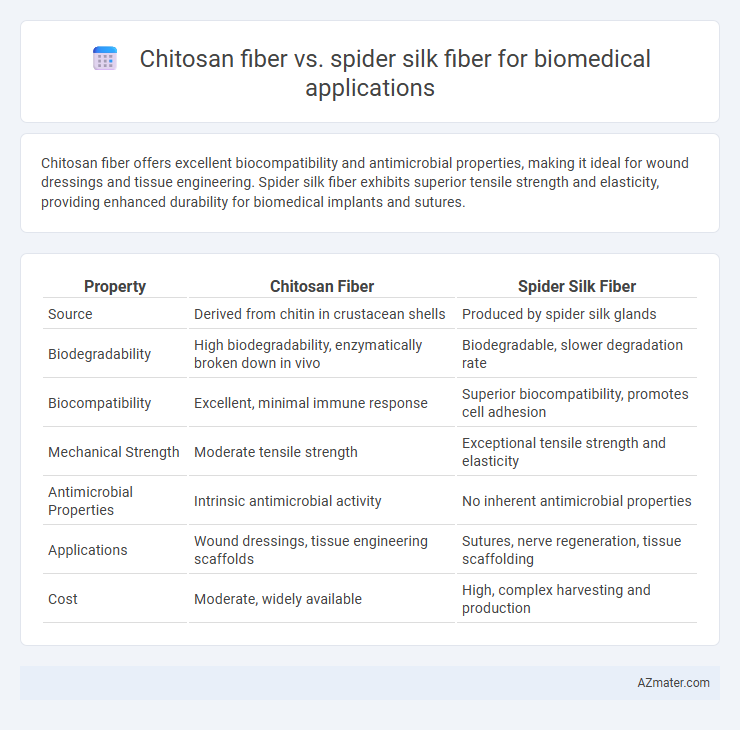Chitosan fiber offers excellent biocompatibility and antimicrobial properties, making it ideal for wound dressings and tissue engineering. Spider silk fiber exhibits superior tensile strength and elasticity, providing enhanced durability for biomedical implants and sutures.
Table of Comparison
| Property | Chitosan Fiber | Spider Silk Fiber |
|---|---|---|
| Source | Derived from chitin in crustacean shells | Produced by spider silk glands |
| Biodegradability | High biodegradability, enzymatically broken down in vivo | Biodegradable, slower degradation rate |
| Biocompatibility | Excellent, minimal immune response | Superior biocompatibility, promotes cell adhesion |
| Mechanical Strength | Moderate tensile strength | Exceptional tensile strength and elasticity |
| Antimicrobial Properties | Intrinsic antimicrobial activity | No inherent antimicrobial properties |
| Applications | Wound dressings, tissue engineering scaffolds | Sutures, nerve regeneration, tissue scaffolding |
| Cost | Moderate, widely available | High, complex harvesting and production |
Introduction to Biopolymer Fibers in Biomedicine
Chitosan fiber and spider silk fiber are two prominent biopolymer fibers utilized in biomedical applications due to their biocompatibility and biodegradability. Chitosan fiber, derived from chitin in crustacean shells, exhibits antimicrobial properties and promotes wound healing, making it suitable for tissue engineering and drug delivery. Spider silk fiber, produced by spiders, is renowned for its exceptional tensile strength and elasticity, providing durable scaffolds for regenerative medicine and sutures.
Overview of Chitosan Fiber: Sources and Structure
Chitosan fiber is derived primarily from chitin, a natural polysaccharide found in the exoskeletons of crustaceans such as shrimp and crabs, making it a sustainable and biodegradable material for biomedical applications. Its molecular structure consists of b-(1-4)-linked D-glucosamine units, which provide excellent biocompatibility, antimicrobial properties, and the ability to promote cell adhesion and wound healing. Compared to spider silk fiber, chitosan fibers offer distinct advantages in drug delivery systems and tissue engineering due to their tunable chemical functionality and ease of modification.
Spider Silk Fiber: Natural Marvel and Composition
Spider silk fiber, composed primarily of fibroin proteins, exhibits exceptional tensile strength, elasticity, and biocompatibility, making it a natural marvel for biomedical applications such as tissue engineering and wound healing. Its unique amino acid sequence, rich in glycine and alanine, forms highly ordered b-sheet nanocrystals that provide remarkable mechanical properties and biodegradability without eliciting immune responses. Compared to chitosan fiber, spider silk's superior toughness and cell-adhesion characteristics enhance its potential for advanced biomaterial scaffolds and drug delivery systems.
Mechanical Properties Comparison
Chitosan fiber exhibits moderate tensile strength and excellent biocompatibility, making it suitable for wound dressings and tissue engineering, while spider silk fiber offers superior tensile strength and elasticity, often exceeding that of steel by weight. The elongation at break for spider silk ranges around 15-35%, far surpassing chitosan fibers, which typically have lower extensibility and more brittle characteristics. These mechanical advantages of spider silk fibers contribute to improved durability and flexibility in biomedical applications requiring dynamic mechanical performance.
Biocompatibility and Cytotoxicity Assessment
Chitosan fiber exhibits excellent biocompatibility due to its natural polysaccharide structure, promoting cell adhesion and proliferation with minimal cytotoxicity, making it highly suitable for biomedical applications such as wound dressings and tissue engineering. Spider silk fiber demonstrates remarkable biocompatibility combined with superior mechanical strength and elasticity, supporting cellular growth while showing negligible cytotoxic effects, thus offering an advantageous scaffold for regenerative medicine. Comparative cytotoxicity assessments highlight that both fibers maintain low inflammatory responses, but chitosan's biodegradability and antimicrobial properties provide additional benefits in biomedical implants.
Degradation and Bioabsorption Profiles
Chitosan fiber demonstrates excellent biodegradability with enzymatic degradation occurring in physiological conditions, promoting favorable bioabsorption profiles ideal for temporary biomedical implants and tissue scaffolding. Spider silk fiber exhibits slower degradation rates due to its highly crystalline protein structure, providing prolonged mechanical support and controlled bioabsorption in regenerative medicine applications. Comparative studies highlight chitosan's rapid resorption and remodeling advantages, while spider silk's durable biofunctionality suits long-term therapeutic uses.
Functionalization and Chemical Modifications
Chitosan fiber exhibits versatile functionalization capabilities through chemical modifications like grafting, cross-linking, and incorporation of bioactive molecules, enhancing its biocompatibility, antimicrobial properties, and wound healing potential in biomedical applications. Spider silk fiber offers excellent mechanical strength and biodegradability, with chemical modifications primarily focused on surface functionalization and recombinant techniques to tailor its protein structure for targeted drug delivery and tissue engineering. Both fibers benefit from advanced functionalization strategies that improve cell adhesion, controlled release profiles, and integration with biological systems, making them promising materials in regenerative medicine and implantable devices.
Applications in Tissue Engineering and Regenerative Medicine
Chitosan fiber exhibits excellent biocompatibility, biodegradability, and antimicrobial properties, making it ideal for scaffold materials in tissue engineering and wound healing applications. Spider silk fiber offers exceptional mechanical strength, elasticity, and biocompatibility, providing superior support for cell proliferation and differentiation in regenerative medicine. Both fibers promote extracellular matrix formation and enhance tissue regeneration, with chitosan favoring antimicrobial environments and spider silk supporting long-term mechanical stability.
Challenges in Large-Scale Production
Chitosan fiber faces challenges in large-scale production due to its limited solubility and the complex extraction process from crustacean shells, resulting in inconsistent fiber quality and batch-to-batch variability. Spider silk fiber production is hindered by difficulties in replicating the spider's natural spinning process, leading to low yield and high costs in recombinant protein synthesis and fiber spinning techniques. Both fibers require advancements in scalable bioprocessing technologies and cost-effective manufacturing to meet the demand in biomedical applications such as tissue engineering and wound healing.
Future Prospects and Research Directions
Chitosan fiber exhibits promising biocompatibility and antimicrobial properties, making it ideal for wound healing and tissue engineering; ongoing research focuses on enhancing its mechanical strength and biodegradability. Spider silk fiber, renowned for exceptional tensile strength and elasticity, shows potential in regenerative medicine and implantable devices, with future studies aimed at scalable production and functionalization. Emerging research directions emphasize hybrid composites combining chitosan and spider silk to leverage synergistic bioactivity and mechanical performance for advanced biomedical applications.

Infographic: Chitosan fiber vs Spider silk fiber for Biomedical
 azmater.com
azmater.com